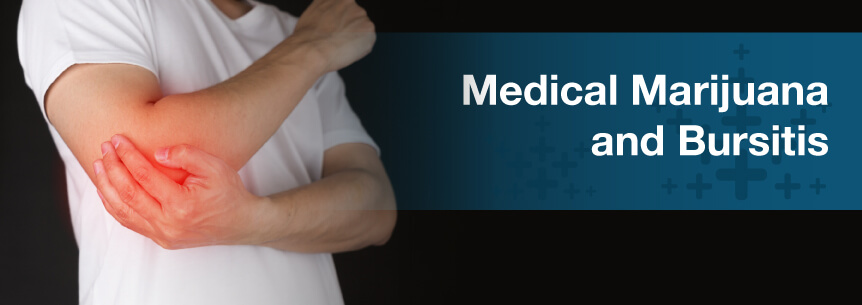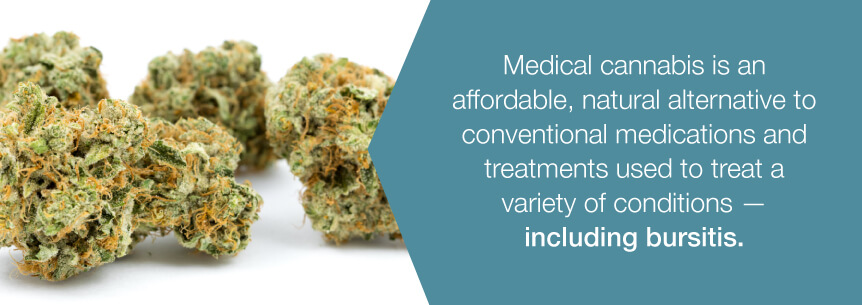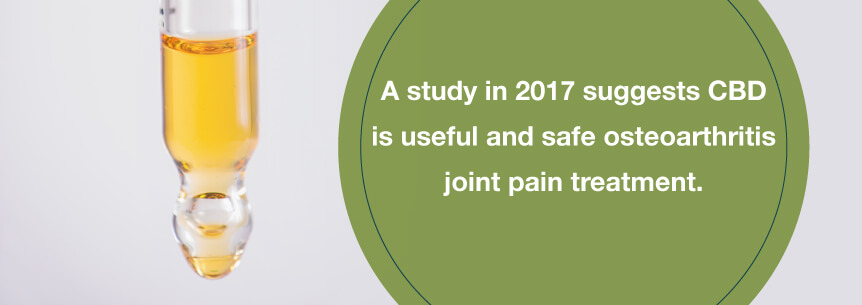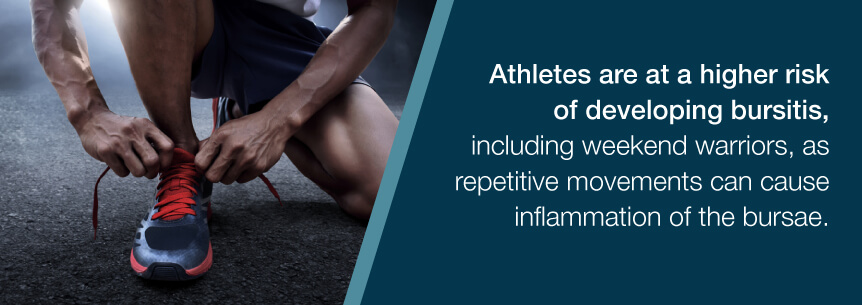
Joint pain corresponds with arthritis, but a similar condition — known as bursitis — can also cause pain and swelling near the joints. Bursitis is a fairly common condition with about 200,000 cases in the U.S. annually. Bursitis can occur in anyone, although the risk increases with age.
While you can treat mild cases of bursitis with home care and medications, individuals are also leaning to medical marijuana and bursitis to manage the pain and inflammation the condition causes.
Medical cannabis is an affordable, natural alternative to conventional medications and treatments used to treat a variety of conditions — including bursitis. It doesn’t have the risk of harmful side effects like you get with other conventional medications.
Find A Doctor Find A Dispensary

Many patients suffering from inflammation-related conditions like arthritis have found the treatment to:
Chronic pain like you experience with bursitis can be an incapacitating condition affecting all aspects of your life. It can make simple tasks like tying your shoes, buttoning your shirt and brushing your hair challenging. After a while, chronic pain can take its toll, and because of your constant battle with pain, you may start feeling depressed.
Medical marijuana and bursitis can significantly ease your chronic pain and other symptoms as well as improve your quality of life. It’s an effective and much safer option for treatment.
The Hebrew University in Jerusalem conducted some research found patients who used cannabis were able to decrease the number of NSAIDs or non-steroidal anti-inflammatory drugs they use. NSAIDs can present numerous side effects that can be potentially harmful and further complicate your bursitis-related problems. The researchers found medical marijuana contained an acid component with as many anti-inflammatory qualities as the medication “indomethacin,” but didn’t have the same gastrointestinal side effects.
Most classes of cannabinoids show anti-inflammatory action, including:
One example published that’s interesting is caryophyllene — a plentiful cannabis oil component. This component showed a high association with the CB2 receptor and anti-inflammatory activity.
A few other animal studies showing CBDs effectiveness in relieving inflammatory pain and treating conditions like arthritis include:

If you’re looking for pain relief and don’t want to get the “high” sensation, CBD is the answer since it’s non-psychoactive, unlike THC and doesn’t produce mental effects.
Cannabis and bursitis treatment can effectively help with symptoms related to your bursitis like:
Medical pot has long been recognized for helping with numerous debilitating situations and medical conditions. Those having to live with joint-related pain like bursitis can benefit especially from cannabis and bursitis treatment. Some good strains to help with your symptoms include:
Other strains effective in treating arthritis can also be helpful for your bursitis pain and symptoms. For instance, you can try Pennywise an indica strain or AC/DC a sativa strain. Cannatonic, a hybrid strain, gives you a nice mellow and relaxing high that can promote pain relief.
You’ll find numerous ways of consuming your marijuana. These include:
Try making some delicious drinks or smoothies with raw cannabis. Consuming cannabis fresh provides you with its full medicinal benefits.
Similar to Tiger Balm or IcyHot, a topical CBD salve can help relieve pain from your joints and muscles affected by bursitis. Talk to your budtender to acquire the type of CBD oil or topical balm, lotion or salve that may help you. Because topicals don’t pass through your bloodstream, they won’t get you high. Instead, they will provide you with the potential for localized relief.
Topicals are great for first-time marijuana users when experiencing localized aches or pains. Even though CBD topicals aren’t psychotropic and won’t get you high, they are still a cannabis product. Therefore, you need to have a qualified medical marijuana doctor recommend them to you and obtain your medical marijuana card to purchase them.
Smoking marijuana is also an option for consumption. However, it can adversely affect the lungs, so other methods to consume cannabis are often recommended before smoking it.
Continuing evidence is popping up all the time supporting medical weed as being an effective and safe option for treating chronic pain and inflammatory-type conditions. Although more studies are needed to show the exact way cannabis works in relieving pain, it’s quickly becoming an important treatment option these days.
If you’re interested in learning more about medical marijuana and bursitis or any other condition, we encourage you to peruse our comprehensive website MarijuanaDoctors.com. Then, when you’re ready to book an appointment with a qualified medical marijuana doctor and find a cannabis dispensary for your medical marijuana and bursitis products.
Find A Doctor Find A Dispensary
Bursitis is a painful condition in which the bursae, or fluid-filled sacs around the joints, become swollen and inflamed. The bursae are important for proper joint function as they help them comfortably move while cushioning the tendons, bones and ligaments as they move. Bursitis may clear up on its own, but an attack of bursitis can cause pain, swelling, reduced range of motion and mobility issues.
Bursitis is usually the result of overuse of a joint, but trauma may also cause it. Even leaning or kneeling on hard surfaces for an extended period can increase the risk of bursitis. People who are in weak health, have poor posture or live a sedentary life are at a higher risk of bursitis. Also, people who are very active, such as athletes are also prone to the condition. In some cases, even infection can lead to bursitis. Some diseases, like diabetes and arthritis, are linked with bursitis.
Bursitis can occur at any bursa in the body, although it tends to occur in the most frequently used joints. The most common forms of bursitis include:

While these are the most common forms of the condition, bursitis can occur at any joint, including the base of the big toe, the heel and the wrist.
Bursitis can also be acute or chronic. Acute bursitis flares up and can last hours or days. Chronic bursitis can last anywhere from a few days to several weeks or longer. You can also have recurrent bursitis that comes and goes.
The first sign of bursitis is usually pain near the affected joint along with tenderness and visible swelling. Bursitis pain tends to be at its worst when you use the joint, but many people also experience pain at night while trying to rest. Joint pain can be disabling, depending on the severity of the swelling. Bursitis can also come with a sudden inability to move the joint.
A joint affected by bursitis may feel stiff or achy, hurt when it’s touched or moved, and look red and swollen, with or without a rash.
While bursitis usually clears up within a few weeks or several months with treatment, the pain and swelling can be disabling and prevent normal use of the affected joint. Some cases of bursitis even require surgical treatment, which comes with its risks and recovery.
Sometimes a bursa is infected as well as inflamed. This condition is called septic bursitis, and it affects an estimated 20 percent of all bursitis cases. Septic bursitis is very serious and may be life-threatening if the infection spreads to the bloodstream or other parts of the body. Septic bursitis has the same symptoms as standard bursitis as well as fever, a general feeling of being sick, extreme redness or warmth of the affected joint, and extreme tenderness of the joint.
People who have chronic bursitis may experience problems with sleep and may develop depression.
Facts surrounding bursitis include:

You can use treat a standard case of bursitis with rest, elevation, compression and ice packs. Over-the-counter pain medication and non-steroidal anti-inflammatory medication may also be recommended to reduce inflammation and swelling as well as to relieve pain associated with hip bursitis.
These include:
Primary care physicians, rheumatologists, physical therapist and sports medicine specialist all can treat bursitis. Your physician may use cortisone injections to immediately reduce inflammation and improve range of motion, although physicians don’t recommend cortisone as a long-term treatment. If the infection is suspected, your doctor may aspirate the bursa fluid for lab evaluation. Physicians sometimes suggest ultrasound and physiotherapy in the treatment of some cases of bursitis.
Septic bursitis should be treated with antibiotics to clear up the infection before it spreads. The inflamed and infected fluid may also be aspirated repeatedly. Some people require surgical drainage and removal of the bursa sac in a procedure called a bursectomy.
Bursitis usually disappears within a few weeks of treatment, although some cases reoccur or persist for a longer period. In these cases, surgery may be recommended to repair or remove the inflamed bursa sac.
While surgery is uncommon for hip bursitis, physicians are using a new procedure involving the arthroscopic removal of a bursa. Because the technique is less invasive than many surgeries, you can recover more quickly from the procedure. It’s early on in the use of this technique, but its treatment effectiveness is promising.